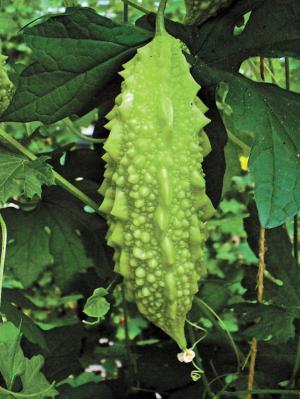Try growing your own karela or bitter melon
In Italy, a disease would break out with symptoms including fever, vomiting, tiredness and headaches, and even death. Since this disease often occurred near stagnant water, the Italians called it "bad air."
Traditional medicines include the bark of the cinchona tree or quinine. In Eastern traditional medicine, people often use a bitter melon (Momordica charantia) to treat malaria. The bitter flavor comes from the quinine in it, so in many countries, bitter melon is used to treat malaria.
The bitter melon's slim, spiny cucumber-like fruits are often called karela, balsam pear or bitter gourd. Bitter melon is usually eaten cooked in the green stage. You can also eat the young shoots and leaves as greens. Because of its bitter flavor it is often used in stir fries, soups and dim sum. The leaves can be brewed into an herbal tea. Bitter melon has iron and is high in beta carotene, potassium, calcium phosphorous, and many vitamins, including vitamins C, B1, B2 and B3. This beautiful fruit is an acquired taste, with slight bitterness similar to lemons or dark chocolate. Yet it is this strong flavor that makes it so appealing.
In Indian cuisine, bitter melon is served with a side of yogurt to tame the bitterness. Cut up, it can be added to soups and curries.
Of the two types of bitter melons, the one from India is most popular. These are the slim, light-green fruits with spiny skin. The Chinese bitter melons are much larger and ridged, with a milder flavor. Karela is a short-lived perennial climber often grown as an annual. It does best on a trellis or fence.
The yellow flowers are either male or female, but occur on the same vine, so with the help of insects they can pollinate themselves.
You can find seeds online or in nurseries and garden stores. For better germination, scarify the seeds to remove the outer seed coat. Carefully rub the large seeds, taking care you don't damage their insides. You can also soak your seeds overnight before planting.
Sow the seeds directly into the garden or start them indoors in pots. Only plant them outside after all danger of frost has passed and the ground has warmed up. Even though it can grow in almost any soil, it does best in well-drained, rich soil high in organic matter. It prefers a soil pH between 6 and 7.1.
Once established karela will tolerate light drought though best yields are by keeping the soil evenly moist but not soggy. Growing bitter melon in pots is similar to starting cucumbers or melons. Choose a big pot at least 12 inches deep and fit it out with a sturdy five- or six-foot trellis. Keep your potted karela in full sun. Bear in mind this is one long trailing vine, so be prepared to let it climb.
Be careful when fertilizing because too much nitrogen encourages the growth of leaves with few, if any fruits. The best fertilizer, of course, is compost or well-rotted manure. If your plants look a bit pale or aren't thriving try a slow-release organic fertilizer.
While pollination is usually done by bees, you may need to pollinte them by hand using a soft artist brush. Your plants should begin bearing fruit in as little as two months. Pick the fruits when they are greenish-yellow, three to six inches long.
For an interesting vine with peculiar fruit, try growing your own karela or bitter melon. Its healthful fruits will be a welcome addition to your summer cooking.
While it won't treat your malaria or "bad air" it will treat your taste buds. As they say in Italy, "Mangia bene, ridi spesso, ama molto." Eat well, laugh often, love much.

















































